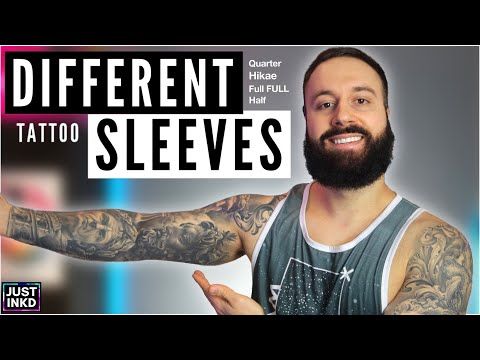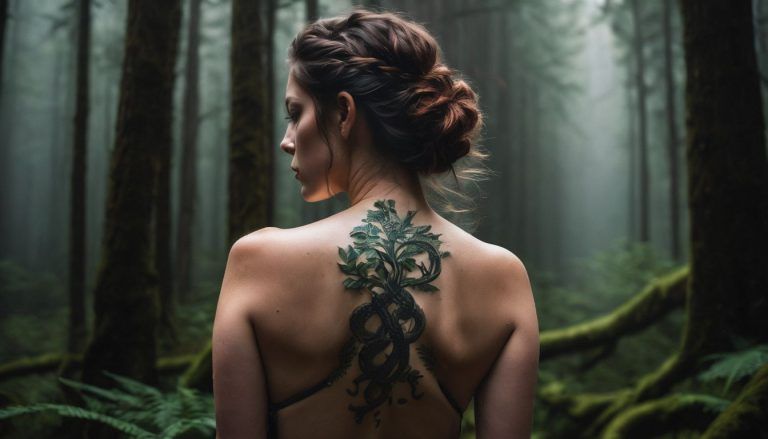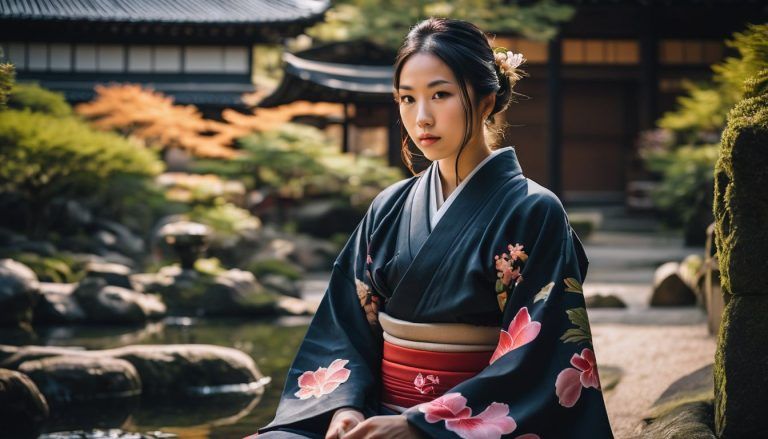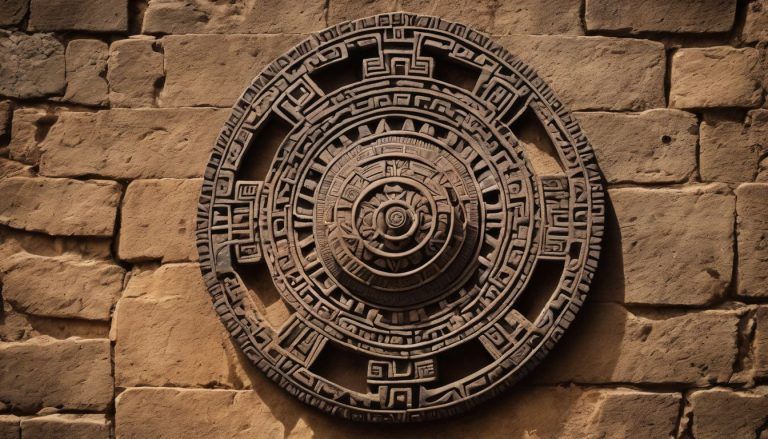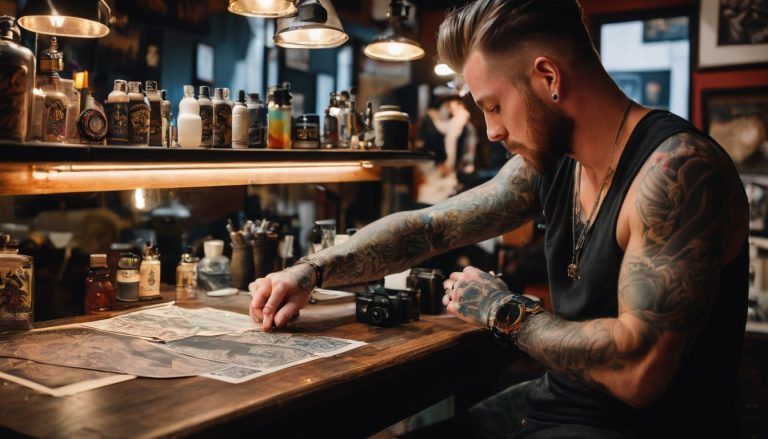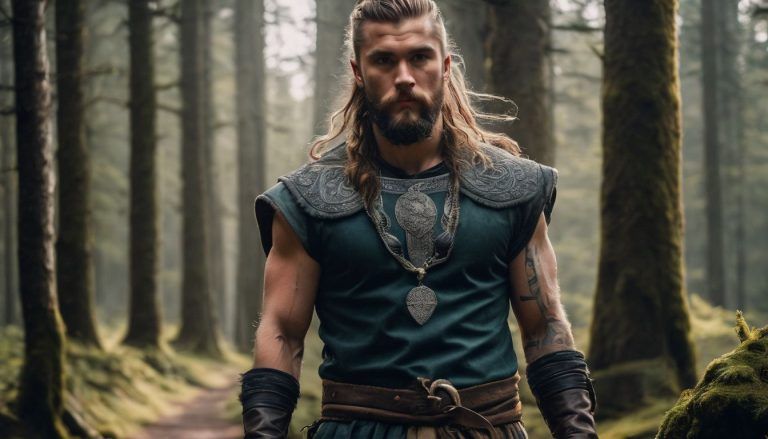Ultimate Guide to Getting a Full Sleeve Tattoo
Thinking about transforming your arm with a full sleeve tattoo? Sleeve tattoos are more than just body art; they’re a personal statement and a form of self-expression. This ultimate guide will outline everything you need to know, from picking the right design to aftercare tips.
Keep reading for the secrets to inking your perfect sleeve!
Key Takeaways
- Consider the different types of sleeve tattoos like full, half, three-quarter, and quarter sleeves to decide how much of your arm you want covered.
- Research tattoo artists thoroughly and look for someone who specializes in the style you desire for a quality result.
- Expect multiple tattoo sessions and plan both design and budget with your artist; full sleeves can be costly due to their size and detail.
- Sleeve tattoos require significant aftercare to ensure proper healing; follow all instructions from your tattoo artist closely.
- Be prepared for the pain associated with getting a sleeve tattoo as it covers a large area with repeated needle insertion.
What is a Sleeve Tattoo?
A sleeve tattoo is a large tattoo that covers the entire arm, either from shoulder to wrist (full sleeve), from shoulder to elbow (half sleeve), or from elbow to wrist (three-quarter arm).
The process of getting a sleeve tattoo involves multiple sessions and careful planning of the design and placement.
Different types
Sleeve tattoos come in numerous designs, each with its own appeal and complexity. They can transform an entire arm into a piece of art, showcasing personal stories or aesthetic preferences.
- Full Sleeve: Covers the arm from shoulder to wrist, creating a comprehensive arm design. Tattoo artists typically begin at the shoulder, crafting elaborate artwork that flows seamlessly down to the wrist.
- Half Sleeve: Encompasses either the upper arm from shoulder to elbow or lower arm from elbow to wrist. It’s ideal for those seeking extensive tattoo work without covering their entire arm.
- Three-Quarter Sleeve: Extends from the shoulder roughly three-quarters down towards the wrist, stopping just short of a full sleeve. This type offers a substantial canvas for intricate tattoo art while leaving some skin untouched.
- Quarter Sleeve: This variety covers the shoulder area down to mid-bicep. Although smaller than other sleeves, it still allows for detailed arm tattoo designs within a more confined space.
Process of getting a sleeve tattoo
To get a sleeve tattoo, find a reputable tattoo artist with experience in creating sleeve tattoos. Discuss your ideas and the design you have in mind. Research local tattoo parlors to find the right fit for your sleeve tattoo artist. Look for an artist who specializes in the style you want.
Things to Consider Before Getting a Sleeve Tattoo
Before getting a sleeve tattoo, it is important to carefully choose the right artist, plan the design and placement of the tattoo, and consider factors such as cost and pain. These decisions will ultimately affect the outcome and satisfaction of your sleeve tattoo.
Choosing the right artist
Selecting the right tattoo artist is crucial for a successful sleeve tattoo. Research artists based on their portfolio, style, and client reviews to ensure they can execute your vision.
Ask about their experience with full-sleeve designs and discuss any concerns you may have about pain or design intricacy. It’s essential to feel comfortable and confident in your chosen artist before embarking on this extensive arm artwork.
Once you’ve found an artist whose work resonates with you, schedule a consultation to further assess their capabilities and expertise. Look for someone who understands your ideas and has the skills to bring them to life.
Communicating openly with the artist will be key in bringing your sleeve tattoo aspirations to fruition.
Planning the design and placement
Consider the theme and style that resonates with you before selecting a design for your sleeve tattoo. It is important to take into account the flow of the artwork across your arm, ensuring cohesiveness from shoulder to wrist.
Discuss your ideas with a reputable artist who can help bring your vision to life, taking care to select a placement that complements the natural contours of your arm. When planning a full sleeve tattoo, it’s crucial to think about how each element will fit together as part of an interconnected piece, creating an impactful visual narrative.
Researching different styles and themes will also aid in deciding where on the arm specific elements should be placed. Remember to consider both personal significance and aesthetic appeal when choosing design elements for your full sleeve tattoo.
Cost and pain factor
Considering the extensive nature of sleeve tattoos, it’s crucial to acknowledge the cost and pain involved. Full sleeve tattoos typically require multiple sessions, which can result in a higher overall cost compared to smaller designs.
Tattoo artists often charge an hourly rate for their services, so intricate and detailed designs might incur higher expenses. It’s essential to prioritize quality over price when choosing an artist for your full sleeve tattoo, as cheaper options may not guarantee the desired results.
In terms of pain, getting a full sleeve tattoo can be a significant commitment due to the extended duration of each session. The process involves repeated needle insertions into the skin, resulting in discomfort or even pain for some individuals.
Types of Sleeve Tattoos
There are different types of sleeve tattoos, including full sleeves, half sleeves, and three-quarter arm tattoos. Each type offers a unique canvas for artistic expression and requires different levels of commitment in terms of time and pain.
Full sleeve
A full sleeve tattoo covers the entire arm from shoulder to wrist, creating a cohesive and impactful design that is often intricate and elaborate. It provides an opportunity for extensive self-expression and storytelling through detailed artwork.
Full sleeve tattoos are known for their ability to showcase a variety of styles, themes, and colors due to the large canvas they offer. Whether it’s a traditional Japanese or vibrant watercolor design, a full sleeve tattoo allows for complete creativity in showcasing personal interests, beliefs, or cultural heritage.
Tattoo cost
Tattoo ideas
Complete arm tattoo
Half sleeve
Half sleeve tattoos are a popular choice for those who want a more subtle but still impactful tattoo on their arm. These tattoos typically cover the upper arm or forearm, offering versatility in design and placement.
They are also a great option for individuals wanting to test the waters before committing to a full sleeve tattoo. When planning for a half sleeve tattoo, it’s essential to consider the theme and placement carefully in order to achieve the desired look.
With various styles and designs available, from traditional to watercolor, there are plenty of options to explore when considering a half sleeve tattoo.
When choosing a half sleeve tattoo, be mindful of how it complements your personal style and interests. Incorporating meaningful symbols or images can make your half-sleeve design truly unique.
Depending on whether you opt for color or black and grey ink, half sleeves can range from bold statements to more understated pieces; ensuring that the chosen artist understands your vision is crucial.
Three-quarter arm
Moving on from the concept of a half sleeve, another option is the three-quarter arm tattoo. This type of sleeve typically covers most of the upper arm but stops short of reaching the wrist.
The advantage of a three-quarter arm tattoo is that it allows for more flexibility in terms of design and placement compared to a full sleeve. Some popular ideas for this style include intricate patterns, meaningful symbols, or themed designs that flow seamlessly across the upper arm area.
When considering a three-quarter arm tattoo, it’s essential to think about how it will integrate with any existing tattoos or future pieces you may want to add. It’s also important to ensure that any design choices complement your body shape and skin tone.
Popular Styles of Sleeve Tattoos
Traditional, black and grey, Japanese/Oriental, realism, watercolor, and geometric styles are some of the most popular choices for sleeve tattoos. Read more to explore which style suits you best!
Traditional
The traditional sleeve tattoo style is rooted in the historic American tattooing tradition, featuring bold black outlines and a vibrant color palette. This style often includes iconic imagery such as anchors, roses, and swallows, representing themes like love, strength, and freedom.
Traditional sleeve tattoos are known for their timeless appeal and are an excellent choice for individuals seeking classic designs that stand the test of time.
Moving on to “Black and Grey” sleeve tattoos..
Black and grey
Black and grey sleeve tattoos are a timeless choice, often conveying a sense of sophistication and depth. They can range from realistic portraits to intricate patterns, all done solely in shades of black and grey.
This style is versatile, as it works well with various themes such as realism, traditional motifs, or even Japanese designs. When considering a black and grey sleeve tattoo, emphasize the importance of finding an artist experienced in this specific style to ensure the details and shading are expertly executed.
Skilled artists like those at Chronic Ink Tattoo have extensive experience creating stunning black and grey sleeve tattoos that stand the test of time.
Japanese/Oriental
Japanese/Oriental sleeve tattoos are known for their intricate and detailed designs, often featuring traditional Japanese motifs such as koi fish, dragons, cherry blossoms, or geishas.
These tattoos typically incorporate bold lines and vibrant colors to create visually stunning and captivating artwork on the skin. The rich cultural history of Japan provides a myriad of symbols and imagery that can be incorporated into a sleeve tattoo design, making it a popular choice for those seeking meaningful and eye-catching body art.
When considering a Japanese/Oriental sleeve tattoo, it’s essential to find an artist with experience in this specific style to ensure the highest quality execution of the design, capturing the essence of traditional Japanese artistry.
Incorporating elements of Japanese mythology and symbolism into an arm sleeve tattoo allows individuals to showcase their appreciation for Eastern culture while expressing personal significance through the chosen motifs.
Realism
Realism sleeve tattoos aim to replicate real-life images with ultra-detailed precision and lifelike shading techniques. These tattoos often depict portraits, animals, or natural scenery, creating a stunning visual impact on the arm.
The process of designing and tattooing realism sleeves involves meticulous attention to detail and skilled execution by a talented artist. Chronic Ink Tattoo artists are experienced in bringing realistic designs to life, capturing intricate details like facial expressions or delicate textures with impressive accuracy.
The demand for realism sleeve tattoos continues to grow as people seek to showcase their passions, memories, or beliefs through strikingly detailed artwork. With advancements in tattoo technology and techniques, artists can achieve remarkable levels of realism that captivate the eye and tell compelling stories through ink.
Watercolor
Watercolor sleeve tattoos are characterized by their soft, blended colors and fluid brushstroke-like appearance. This style often incorporates pastel hues and light washes that create a dreamy, ethereal effect on the skin.
The watercolor technique is ideal for those seeking a unique and artistic sleeve design, as it allows for seamless transitions between different elements and gives the tattoo an almost painting-like quality.
When considering a watercolor sleeve tattoo, it’s important to find an experienced artist who specializes in this specific style. Watercolor tattoos require precision and skill to achieve the desired delicate look while maintaining longevity over time.
Additionally, incorporating meaningful symbols or imagery into the design can add depth to the overall aesthetic of the watercolor sleeve. As you explore various options for your full arm artwork, keep in mind that regular touch-ups may be necessary to preserve the vibrancy of the colors.
Geometric
Geometric sleeve tattoos incorporate angular shapes and precise lines to create visually striking designs. These tattoos often feature intricate patterns, such as mandalas, sacred geometry, or symmetrical shapes.
Geometric designs are versatile and can be adapted to fit various parts of the arm, making them a popular choice for full sleeves. The clean lines and bold shapes of geometric sleeve tattoos make for an eye-catching and modern look that appeals to those with a contemporary aesthetic.
When it comes to choosing a sleeve tattoo design, the geometric style offers endless opportunities for customization and creativity. By combining different geometric elements like triangles, circles, or polygons with other styles such as black and grey or watercolor, individuals can create unique and personalized full sleeve designs that reflect their individuality.
Sleeve Tattoo Ideas and Inspiration
Explore full sleeve designs, half sleeve designs, incorporating color, themed tattoos, and personalized designs to find inspiration for your own unique sleeve tattoo.
Full sleeve designs
Designing a full sleeve tattoo involves covering the entire arm with an intricate and elaborate design, making a bold and impactful statement. Here are some popular full sleeve designs to consider:
- Traditional Style: This design incorporates classic tattoo elements such as anchors, roses, and skulls in vibrant colors, perfect for those who appreciate timeless art.
- Black and Grey Realism: Utilizing shades of black and grey, this style creates realistic portraits or detailed scenes, showcasing unparalleled artistry.
- Japanese/Oriental Themes: Inspired by traditional Japanese artwork, this style features intricate patterns, mythical creatures, and symbolic motifs with vibrant colors.
- Realism with Color Accents: Adding pops of color to realistic images brings life to the design, creating a captivating visual impact.
- Geometric Patterns: Incorporating geometric shapes into the design adds a modern and edgy touch to the sleeve tattoo, creating a visually stunning piece of art.
- Watercolor Technique: Using soft lines and blending colors gives the impression of watercolor painting on the skin, allowing for unique and ethereal designs.
- Themed Tattoos: Creating a cohesive theme throughout the sleeve tattoo, such as nature-inspired or celestial motifs, tells a story through interconnected elements.
- Personalized Designs: Tailoring the design to reflect personal experiences or meaningful symbols ensures that the full sleeve tattoo holds deep significance for its wearer.
Half sleeve designs
After considering full sleeve designs, half sleeve designs are also a popular option for tattoo enthusiasts. Here are some popular half sleeve design ideas to consider:
- Traditional Half Sleeve: This style incorporates classic tattoo elements such as anchors, roses, and daggers in a bold and vibrant color palette.
- Black and Grey Half Sleeve: Utilizing shades of black and grey, this style can create stunning realism with detailed shading and intricate linework.
- Japanese/Oriental Half Sleeve: Drawing inspiration from traditional Japanese art, these designs often feature iconic motifs like dragons, koi fish, or cherry blossoms.
- Realism Half Sleeve: Known for its lifelike portrayal of subjects, realism half sleeves can feature portraits or nature scenes with astonishing detail.
- Watercolor Half Sleeve: This unique style mimics the appearance of watercolor paintings, using soft washes of color and abstract forms to create a dreamy aesthetic.
- Geometric Half Sleeve: Incorporating geometric shapes and patterns, this modern style offers a contemporary and visually striking look.
Incorporating color
Sleeve tattoos can be enhanced with the use of color, adding vibrancy and dimension to the artwork. The strategic incorporation of color can bring a sleeve tattoo to life, making it stand out and allowing for more creative expression.
Different styles such as traditional, Japanese/Oriental, or watercolor offer unique opportunities for using color in sleeve tattoos, giving individuals the chance to choose a style that reflects their personality and preferences.
When choosing colors for your sleeve tattoo design, consider how they will complement each other and create visual interest within the overall composition. Each hue should be carefully selected to ensure cohesion throughout the entire piece while still allowing individual elements to shine through.
Themed tattoos
Themed tattoos often tell a story or convey a specific message. They are created around a central theme or concept, bringing together different elements into one cohesive design. Themed tattoos can be a powerful way to express personal beliefs, passions, or interests. They allow individuals to share their unique stories through intricate and meaningful artwork. Here are some popular themes for sleeve tattoos:
- Mythological: Incorporating mythical creatures such as dragons, phoenixes, or unicorns can symbolize strength, rebirth, and resilience.
- Nature-inspired: Designs featuring elements like flowers, animals, or landscapes offer a connection to the natural world and can symbolize growth, beauty, and freedom.
- Cultural: Drawing inspiration from cultural symbols, traditions, or art forms can honor heritage and carry significant personal meaning.
- Narrative: Creating a narrative within the tattoo design by depicting scenes or characters from literature, mythology, or personal experiences can add depth and storytelling to the artwork.
- Retro: Embracing vintage aesthetics from specific eras like the 1950s or 1980s can showcase nostalgia and individual style preferences.
- Surreal: Blending reality with fantasy in an abstract way can evoke imagination and introspection.
- Symbolic: Using symbols representing love, courage, wisdom, or resilience can infuse the tattoo with profound meanings relevant to the wearer’s life journey.
Personalized designs
Infuse your personality into your sleeve tattoo with personalized designs that hold special meaning to you. Consider incorporating elements such as important dates, meaningful symbols, or portraits of loved ones to make your sleeve truly unique.
Adding personal touches makes the tattoo a reflection of your individuality and creates a lasting piece of art that tells your story.
When planning personalized designs, explore ideas that resonate with you on a deeper level. Integrate details that represent significant moments or beliefs in your life, ensuring that each element holds personal significance for a tattoo that is not only visually striking but also deeply meaningful.
Conclusion
In conclusion, getting a full sleeve tattoo is an intricate process that requires careful consideration. It’s essential to choose a skilled artist and plan the design and placement thoughtfully.
Proper aftercare is crucial for allowing the tattoo to heal effectively. When done right, a full sleeve tattoo can be a meaningful and visually stunning form of self-expression.
FAQs
1. What is a full sleeve tattoo?
A full sleeve tattoo is an elaborate and extensive tattoo that covers your complete arm, from shoulder to wrist.
2. How much does it cost to get a full sleeve tattoo?
The cost of a full sleeve tattoo varies depending on the intricate design, but it’s usually a significant investment because of its size and complexity.
3. Does getting a full sleeve tattoo hurt?
Yes, getting any tattoo can involve pain, and since a full sleeve covers such a large area of the arm, you’ll need to prepare for several sessions under the needle.
4. How should I take care of my new full sleeve tattoo?
Tattoo aftercare is crucial; always follow your artist’s instructions which typically include keeping it clean, moisturized, avoiding sunlight and not picking at scabs during healing.




